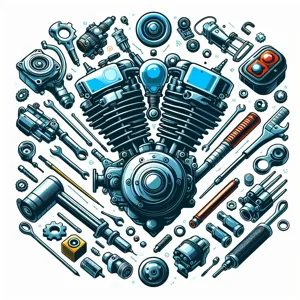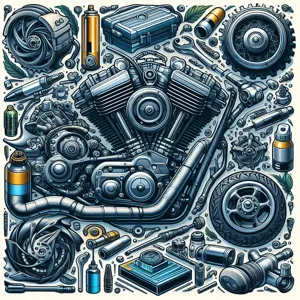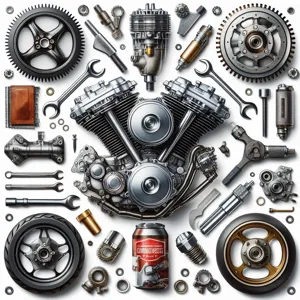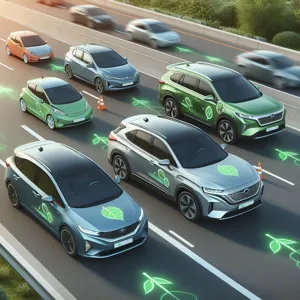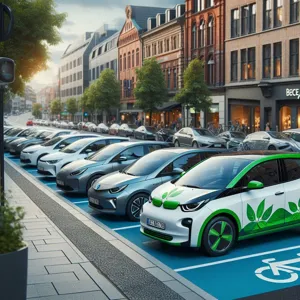There’s nothing quite like the thrill of riding a motorbike—the wind in your hair, the open road ahead, and the sense of freedom that comes with every twist and turn.
However, every rider knows that with great adventure can come unexpected challenges. Whether you’re a seasoned rider or a new enthusiast, encountering mechanical issues is an inevitable part of the journey. From sputtering engines to stubborn brakes, motorbike problems can quickly turn your joyride into a frustrating ordeal. In this comprehensive guide, we’ll delve into the most common motorbike issues you might face on the road and provide you with practical troubleshooting tips to help you master the ride. With our expertise at your fingertips, you’ll be equipped to handle any hiccup with confidence, ensuring that your adventures remain as exhilarating as they should be. So, gear up and get ready to hit the road prepared—because every great ride deserves a smooth journey!
1. Introduction to Common Motorbike Problems

Motorbikes are not just a mode of transportation; they embody freedom, adventure, and a sense of connection with the open road. However, like any machine, they can encounter a variety of issues that may disrupt that exhilarating experience. Understanding common motorbike problems is essential for every rider, whether you’re a seasoned enthusiast or a newcomer eager to hit the pavement.
In this section, we’ll delve into the most frequent issues that motorbike owners face, from the frustrating to the alarming. Imagine setting out on a beautiful sunny day, only to find your bike won’t start; the disappointment can be palpable. Or perhaps you’ve experienced the unsettling sensation of your bike wobbling unexpectedly while cruising down the highway. These problems can range from minor inconveniences, like a flat tire or a dead battery, to more serious complications involving the engine or braking systems.
Being proactive and knowledgeable about these common issues can save you time, money, and the headache of unexpected breakdowns. We’ll explore the symptoms to watch for, potential causes behind each problem, and practical troubleshooting tips to help you get back on the road with confidence. So, let’s gear up and embark on a journey through the most prevalent motorbike problems and learn how to master the ride!
2. Understanding Your Motorbike’s Mechanics
Understanding your motorbike’s mechanics is crucial for any rider who wants to ensure a smooth and safe ride. Your bike is a complex machine, composed of various systems that must work in harmony to deliver the exhilarating experience that motorbiking offers. By familiarizing yourself with the fundamental components and mechanics of your motorbike, you empower yourself to identify potential issues before they escalate into significant problems.
Start with the engine—the heart of your motorbike. It’s essential to understand how it operates, including the functions of key components like the pistons, valves, and spark plugs. A well-functioning engine provides the power you need, while irregularities such as unusual noises or decreased acceleration can indicate underlying issues. Pay close attention to the engine oil; regular checks and timely changes can prolong its life and enhance performance.
Next, dive into the braking system, which is vital for your safety. Understand the differences between disc and drum brakes, and familiarize yourself with the mechanics of brake pads and rotors. Regularly inspect these components for wear and tear, as well as the brake fluid levels, to ensure your stopping power is reliable.
Don’t overlook the electrical system either; it powers everything from your lights to your ignition. Learning how to troubleshoot common electrical issues, like a dead battery or faulty wiring, can save you from getting stranded. Keep an eye on your battery terminals for corrosion and ensure connections are secure.
Finally, familiarize yourself with the suspension and tires. The suspension system impacts your bike’s stability and handling, while properly inflated and well-maintained tires are critical for traction and safety. Regularly check tire pressure and tread depth, and be vigilant for any signs of wear.
By cultivating a strong understanding of your motorbike’s mechanics, you not only enhance your riding experience but also build confidence in your ability to tackle common problems. Remember, a well-maintained motorbike is a safer and more enjoyable ride, turning every journey into an adventure rather than a potential headache.
3. Essential Tools for Troubleshooting

When it comes to troubleshooting common motorbike problems, having the right tools at your disposal can make all the difference between a minor inconvenience and a full-blown repair disaster. Equipping yourself with a well-curated toolkit not only empowers you to tackle issues head-on but also enhances your confidence as a rider. Here are the essential tools you should have in your arsenal:
1. **Basic Socket Set**: A good socket set is the backbone of any mechanic’s toolkit. Look for a set that includes a variety of sizes, as motorbike components can vary widely. A ratchet and a selection of sockets will enable you to quickly remove and replace bolts, whether you’re adjusting your handlebars or performing a full engine overhaul.
2. **Torque Wrench**: Properly torquing bolts is crucial for the safety and longevity of your motorbike. A torque wrench ensures that you apply the correct amount of pressure, preventing overtightening that could strip threads or cause damage. This tool is especially vital when working with critical components like the engine and suspension.
3. **Screwdrivers**: A set of screwdrivers in various sizes—both Phillips and flathead—is essential for tackling everything from panel removal to adjusting carburetors. magnetic screwdrivers can save you time by preventing screws from falling into hard-to-reach places.
4. **Pliers and Wrenches**: Needle-nose pliers are perfect for reaching tight spots, while regular pliers can assist with gripping and twisting. A good adjustable wrench is also a must-have for loosening or tightening nuts and bolts of various sizes.
5. **Multimeter**: Electrical issues can be particularly tricky to diagnose, making a multimeter an invaluable tool in your troubleshooting kit. It allows you to test voltage, continuity, and resistance, helping you identify problems in the wiring or components like the battery and ignition system.
6. **Tire Pressure Gauge and Repair Kit**: Your tires are your connection to the road, so keeping them in top shape is vital. A tire pressure gauge helps you monitor the air pressure, while a tire repair kit can be a lifesaver in the event of a flat. Being able to patch a tire on the go can keep you riding instead of waiting for assistance.
7. **Service Manual**: While not a physical tool, having a service manual specific to your motorbike model is crucial. It provides detailed diagrams, maintenance guidelines, and troubleshooting tips tailored to your machine. This resource can guide you through repairs with confidence and accuracy.
By arming yourself with these essential tools, you’ll be well-equipped to tackle a variety of common motorbike problems. Not only will you save money on repairs, but you’ll also deepen your understanding of your bike, leading to a more enjoyable and informed riding experience. Remember, the key to mastering the ride lies not just in your skills on the road but also in your ability to troubleshoot and maintain your machine with confidence.
4. Diagnosing Starting Issues
When it comes to the thrill of riding, few things are more frustrating than a motorbike that refuses to start. Diagnosing starting issues can be a daunting task for any rider, but with a systematic approach, you can pinpoint the problem and get back on the road in no time.
First and foremost, check the basics—ensure that your bike is in neutral and the kickstand is up. It sounds simple, but you’d be surprised how often these preliminary checks are overlooked. Next, listen for any signs of life when you press the starter button. A clicking sound may indicate a weak battery, while silence could suggest a more serious electrical issue.
If the battery is the culprit, it’s worth testing both the voltage and the connections. A fully charged battery should read around 12.6 volts. If the voltage is lower, you may need to jump-start your bike or replace the battery altogether. Don’t forget to inspect the terminals for corrosion or loose connections, as these can impede electrical flow and prevent starting.
If the battery checks out, move on to the fuel system. Ensure there’s gas in the tank and that the fuel shut-off valve is in the correct position. A clogged fuel filter or a malfunctioning fuel pump can also hinder your bike’s ability to start. If you suspect fuel issues, listening for the sound of the fuel pump priming when you turn the key can provide valuable insight.
Next, consider the ignition system. Check the spark plugs for signs of wear, such as fouling or excessive carbon buildup. These little components play a crucial role in starting your bike, and replacing them is often a straightforward solution to starting woes. If you have a multimeter, you can also test the ignition coil for proper voltage output.
Lastly, don’t overlook the importance of the starter relay and the ignition switch. A faulty relay can prevent the starter motor from engaging, while issues with the ignition switch can disrupt the electrical flow required to start your bike. If you’ve checked all other components and still face starting issues, it might be time to consult a professional mechanic for further diagnosis.
By following these troubleshooting steps systematically, you’ll not only develop a better understanding of your motorbike’s inner workings but also empower yourself to tackle starting issues with confidence. Remember, the road awaits, and with a little perseverance, you’ll soon be back enjoying the wind in your hair and the freedom of the open road.
5. Resolving Fuel System Problems

Fuel system problems can be a biker’s worst nightmare, but with a little knowledge and patience, you can troubleshoot and resolve these issues to get back on the road in no time. The fuel system is the heart of your motorbike, responsible for delivering the right amount of fuel to the engine for optimal performance. When something goes awry, it can manifest in a variety of ways—poor acceleration, stalling, or even a bike that won’t start at all.
First, start with the basics: check your fuel level. It may sound simple, but a low fuel tank can lead to the assumption that your bike has a more complex issue. If the fuel is low, fill it up and see if that resolves the problem. If not, proceed to inspect the fuel lines for any signs of leaks, cracks, or blockages. A clogged fuel line can prevent the proper flow of fuel to the engine, ultimately crippling performance.
Next, examine the fuel filter. Over time, filters can become clogged with dirt and debris, restricting fuel flow. If it looks dirty or hasn’t been replaced in a while, swapping it out could make a world of difference. Moving on to the carburetor or fuel injector—depending on your bike’s system—cleaning these components can often solve many fuel-related issues. A buildup of grime can interfere with fuel mixing and delivery, leading to poor performance.
Lastly, if you’re still experiencing problems, consider checking the fuel pump. A failing fuel pump may not provide enough pressure to deliver fuel effectively. Listen for the pump’s operation when you turn the ignition—if you don’t hear that reassuring hum, it might be time for a replacement.
By methodically checking each component of your bike’s fuel system, you can identify and rectify issues that may be plaguing your ride. Regular maintenance and immediate attention to any signs of trouble will help ensure that your motorbike continues to run smoothly, allowing you to enjoy the open road without worry.
6. Addressing Electrical System Failures
When it comes to motorbike maintenance, the electrical system often ranks high on the list of trouble spots. A failure in this critical component can manifest in various ways, from flickering lights and unresponsive ignition switches to complete power loss. Understanding how to troubleshoot these electrical issues is essential for any rider who wants to keep their bike running smoothly.
Start by checking the battery—a common culprit in electrical failures. Ensure that the terminals are clean and tightly connected, as corrosion or loose connections can impede performance. If your bike struggles to start or the lights dim when you rev the engine, it might be time to test the battery voltage with a multimeter. A healthy battery should read around 12.6 volts when fully charged. If the reading is significantly lower, consider replacing the battery to avoid being stranded on your next ride.
Next, examine the fuses. Many modern bikes are equipped with a fuse box that protects the electrical circuits from overloads. Locate the fuse panel, typically found under the seat or side panel, and inspect the fuses for any signs of damage or breakage. A blown fuse is often a straightforward fix, but be sure to replace it with one of the correct amperage to prevent further issues.
Don’t overlook the wiring harness, as frayed or damaged wires can lead to intermittent electrical problems. Look for any signs of wear, such as exposed wires or loose connections, and repair or replace them as necessary. Pay special attention to areas that may be subject to vibration or movement, as these can wear down insulation over time.
Lastly, if your bike features components like the ignition switch, starter relay, or electronic control units, these may also be sources of electrical failure. Testing these parts usually requires a bit more expertise and equipment, so don’t hesitate to consult your bike’s service manual or seek professional help if you’re unsure.
By systematically addressing these potential issues, you can tackle electrical system failures effectively and keep your motorbike in top-notch condition, ensuring that every ride is as exhilarating as the last.
7. Tackling Brake and Suspension Issues

When it comes to the safety and performance of your motorbike, few things are as crucial as your brakes and suspension. These two components work in tandem to provide a smooth, controlled ride, and any issues in these areas can not only compromise your riding experience but also put you at risk on the road.
**Brake Problems**
If you notice that your bike is taking longer to stop than usual or the brakes feel spongy underfoot, it’s a clear sign that something isn’t right. Start by checking the brake fluid level; low fluid can lead to decreased braking performance. If the fluid is fine, inspect the brake pads for wear. Worn-out pads can lead to metal-on-metal contact, which can severely damage your rotors. Listen for any unusual noises when braking—squeaking can indicate debris caught in the system, while grinding suggests immediate attention is needed. Remember, effective brakes are not just about stopping; they are integral to your overall control of the bike.
**Suspension Issues**
The suspension system is responsible for absorbing shocks and ensuring a smooth ride, adapting to various terrains and conditions. If you find your bike feeling bouncy or stiff, or if you notice uneven tire wear, these could be signs of suspension problems. Start by checking the fork seals for leaks; oil leaking from the forks can impact handling and safety. Additionally, inspect the rear shock for any signs of wear. A well-maintained suspension not only enhances comfort but also improves your bike’s stability and cornering capabilities.
In both cases, regular maintenance is key. Make it a habit to perform routine checks on your brakes and suspension, and don’t hesitate to consult with a professional mechanic if you’re unsure about any symptoms. By staying proactive, you’ll ensure that your ride remains smooth, safe, and enjoyable, allowing you to tackle any road with confidence.
8. Managing Overheating Concerns
Managing overheating concerns is crucial for any motorbike enthusiast, as excessive heat can lead to severe engine damage and potentially ruin your riding experience. As you twist the throttle and hit the open road, it’s essential to keep a vigilant eye on your bike’s temperature gauge, especially during those sweltering summer rides or when tackling steep inclines.
One of the most common culprits of overheating is a low coolant level. Regularly check your coolant reservoir to ensure it’s filled to the recommended level. If you find it consistently low, it may indicate a leak in the cooling system. In such cases, inspect hoses and connections for any signs of wear or damage, as even the tiniest crack can lead to significant coolant loss.
Another factor to consider is the condition of your radiator. A clogged or dirty radiator can severely restrict airflow, causing your engine to overheat. Make it a habit to clean your radiator fins, removing any debris or dirt that may have accumulated during your rides. If you notice any bent fins, gently straighten them to restore optimal airflow.
Additionally, pay attention to your bike’s oil level and quality. Engine oil not only lubricates moving parts but also plays a critical role in dissipating heat. Ensure your oil is at the correct level and consider changing it if it appears dark or gritty. Using the right oil type, as specified in your owner’s manual, can also make a substantial difference in heat management.
Lastly, be mindful of your riding habits. Constantly revving the engine or riding at high RPMs can exacerbate overheating issues. Instead, adopt smoother acceleration techniques and allow your bike to cool down during extended stops. If you find yourself stuck in traffic on a hot day, periodically rev the engine while in neutral to help increase airflow to the engine.
By taking these proactive measures, you can effectively manage overheating concerns and keep your motorbike running smoothly. Remember, a well-maintained bike is a happy bike, and your attention to these details will ensure many more enjoyable rides ahead.
9. Troubleshooting Transmission and Clutch Problems
When it comes to the heart of your motorbike’s performance, few components are as crucial as the transmission and clutch. These systems work in harmony to transfer the power generated by your engine to the wheels, enabling you to accelerate smoothly and shift gears with ease. However, issues with either can lead to frustrating riding experiences and, in some cases, unsafe conditions. Therefore, understanding how to troubleshoot common transmission and clutch problems is essential for every rider.
One of the most frequent symptoms of transmission trouble is difficulty shifting gears. If you find yourself struggling to engage a gear or experiencing grinding noises when shifting, it’s time to investigate. Start by checking your clutch lever. Ensure it’s properly adjusted and has the right amount of free play. An improperly adjusted clutch can lead to incomplete disengagement, causing those pesky grinding noises and gear-shifting woes. If adjustments don’t remedy the situation, it may be time to inspect the clutch plates themselves for wear and tear.
Another common issue is slipping gears, where the transmission unexpectedly pops out of gear or refuses to engage. This can stem from various problems, including low transmission fluid levels or a worn-out shift fork. If you suspect low fluid, check the levels and top them off as needed. If the fluid is clean but slipping persists, it’s wise to consult a professional mechanic, as internal transmission repairs can be complex.
Additionally, listen for unusual sounds when operating the bike. Clunking, whining, or rattling noises can indicate serious issues within the transmission or clutch assembly. Don’t ignore these auditory warnings; they can be signs of worn bearings, damaged gears, or other mechanical failures that require immediate attention.
Lastly, make it a habit to conduct regular maintenance checks on your bike’s transmission and clutch systems. This includes ensuring that cables are lubricated and functioning properly, inspecting for leaks, and replacing worn or damaged components promptly. By staying proactive, you can prevent minor issues from escalating into major problems, allowing you to enjoy a smoother, more enjoyable ride. Remember, keeping your transmission and clutch in top shape is key to mastering the ride and ensuring your adventures on two wheels remain thrilling and safe.
10. Dealing with Tire Issues and Maintenance
Tires are the unsung heroes of your motorbike, acting as the crucial point of contact between your ride and the road. Proper tire maintenance is essential for ensuring a smooth, safe, and enjoyable ride. Neglecting this vital aspect can lead to a host of problems, from reduced traction to unexpected blowouts. To master the ride, it’s important to be proactive in dealing with tire issues, understanding when to replace them, and knowing how to maintain them for optimal performance.
First and foremost, regular inspections are key. Check your tires for signs of wear and tear, such as uneven tread wear, cracks, or bulges. Use the penny test to gauge tread depth: insert a penny into the tread with Lincoln’s head facing down. If you can see all of Lincoln’s head, it’s time for a new set of tires. Additionally, keep an eye out for foreign objects embedded in the tire, as these can lead to slow leaks or sudden punctures.
Proper inflation is another critical factor in tire maintenance. Under-inflated tires can negatively impact handling and fuel efficiency, while over-inflated tires can make your ride harsh and increase the risk of a blowout. Invest in a reliable pressure gauge and check your tire pressure regularly, ensuring they match the manufacturer’s recommended levels, which you can find in your bike’s owner manual or on a sticker usually located on the frame.
Rotation and alignment are also vital components to prolonging the life of your tires. Just as with a car, your motorcycle tires should be rotated periodically to ensure even wear. This is especially important for those who ride with a passenger or heavy loads. Additionally, maintaining proper wheel alignment can prevent uneven tire wear and enhance handling, making your rides smoother and safer.
Finally, remember the importance of seasonal considerations. Different weather conditions can affect tire performance. If you live in an area that experiences extreme temperatures or wet conditions, consider investing in specialized tires designed for those conditions. From all-season tires for versatility to wet-weather tires for better grip, choosing the right tires for the right environment can make a world of difference.
By staying vigilant about tire maintenance and addressing issues promptly, you’ll not only enhance your motorbike’s performance but also ensure a safer and more enjoyable riding experience. So, keep those tires in check, and you’ll be well on your way to mastering the ride!
11. Engine Performance: Common Symptoms and Solutions
When it comes to your motorbike’s engine performance, a few telltale signs can indicate underlying issues that may require immediate attention. Understanding these symptoms is essential for maintaining not only your bike’s efficiency but also your safety on the road.
One of the most common indicators of engine trouble is a decrease in power or acceleration. If you find yourself twisting the throttle and your bike is sluggish to respond or struggles to reach higher speeds, it could signify a problem with the fuel delivery system, such as a clogged fuel filter or failing fuel pump. Regular maintenance checks should involve inspecting these components to ensure they’re functioning optimally.
Another frequent symptom is unusual noises emanating from the engine. A knocking or tapping sound can indicate issues with the valve clearance or even more serious problems like worn piston rings. Conversely, if the engine is producing excessive vibrations, it may suggest that the engine mounts are loose or damaged. These noises are not just bothersome; they can be warning signs that if left unaddressed, may lead to more significant damage down the line.
Overheating is another critical issue that can severely impact engine performance. If your bike’s temperature gauge is consistently in the red, it might be due to low coolant levels, a malfunctioning thermostat, or a blocked radiator. Overheating can cause catastrophic engine failure, so it’s vital to investigate the root cause immediately.
Lastly, keep an eye on your exhaust. If you notice dark smoke or an unusual smell, it can be a sign of an incorrect air-fuel mixture, which not only affects performance but can also lead to increased emissions. This can often be resolved by adjusting the carburetor or fuel injection settings.
In summary, being aware of these common symptoms and their potential solutions can help you troubleshoot engine performance issues before they escalate. Regular maintenance checks and being attuned to your bike’s behavior can ensure a smooth and safe riding experience, allowing you to enjoy the journey without unexpected interruptions.
12. Regular Maintenance Practices to Prevent Problems
Regular maintenance practices are essential for ensuring the longevity and optimal performance of your motorbike, preventing issues before they escalate into costly repairs. Think of your motorbike as a finely tuned machine that thrives on attention and care. By integrating a routine maintenance schedule into your riding life, you can significantly reduce the risk of unexpected breakdowns and enhance your overall riding experience.
Start with the basics: regularly checking and changing the oil is crucial. fresh oil lubricates the engine components, reduces friction, and keeps your motorbike running smoothly. aim to change the oil based on the manufacturer’s recommendations, or at least every 3,000 to 5,000 miles, depending on your riding habits.
Tire maintenance is another critical aspect. Inspect your tires for proper inflation, tread wear, and any signs of damage. Maintaining the correct tire pressure not only improves handling but also enhances safety and fuel efficiency. Rotate your tires periodically and replace them when tread depth approaches the minimum limit.
Don’t forget about your brakes! Regularly inspect the brake pads for wear and tear, and ensure that the brake fluid is at the appropriate level. Squeaky or spongy brakes can indicate a need for immediate attention, so address these issues promptly to avoid compromising your safety.
Additionally, make it a habit to clean and lubricate the chain regularly. A well-maintained chain ensures smooth gear shifts and prevents wear on the sprockets. Every few hundred miles, clean the chain with a degreaser and apply a suitable lubricant to keep it in top condition.
Finally, give your motorbike a thorough inspection before long rides. Check the lights, signals, and horn for functionality. Ensure that all electrical systems are operational, as visibility and communication with other road users are vital for your safety.
By committing to these regular maintenance practices, you not only enhance the performance and reliability of your motorbike but also cultivate a deeper connection with your ride, allowing for countless adventures on the open road. Remember, a well-maintained motorbike is not just a machine—it’s a trusted companion that is ready to take you wherever the journey leads.
13. When to Seek Professional Help
While many motorbike enthusiasts relish the challenge of diagnosing and fixing issues on their own, there comes a time when the complexities of a problem necessitate the expertise of a professional. Knowing when to seek professional help can not only save you time and money but can also ensure your safety on the road.
First and foremost, if you find yourself dealing with a problem that is beyond your skill set—such as intricate electrical issues or engine problems—it’s wise to consult a certified mechanic. These professionals possess the training and tools to diagnose complex issues accurately and perform repairs that you may not have the capability or resources to undertake.
Another indicator that it’s time to seek professional assistance is if you’ve attempted to fix a problem but it persists or worsens. For instance, if you’ve replaced a faulty component, like the spark plug, but your bike continues to misfire, it could be a sign that there’s a deeper issue at play. Continuing to tinker without understanding the root cause can lead to more significant damage and costly repairs, so don’t hesitate to reach out to a mechanic who can provide a thorough inspection.
Additionally, if you notice unusual sounds, smells, or performance changes while riding, it’s critical to get your bike checked out immediately. Sounds like grinding, popping, or hissing can indicate serious mechanical issues, while odors such as burning rubber or oil can signal potential hazards. Riding with an unresolved problem can put both you and your bike at risk, so err on the side of caution.
Finally, if you’re approaching a major service milestone—like a significant mileage interval or a seasonal change—it’s a good idea to have your bike inspected by a professional. Regular maintenance can prevent minor issues from escalating into significant problems.
In summary, while diy repairs can be rewarding, recognizing the limits of your own expertise is crucial. If you encounter persistent problems, complicated issues, or signs of serious trouble, don’t hesitate to seek professional help. Your safety and the longevity of your motorbike depend on it.
14. Helpful Resources and Communities for Motorbike Enthusiasts
When it comes to mastering the ride and addressing common motorbike issues, having a wealth of resources at your fingertips can make all the difference. Fortunately, the vibrant world of motorbike enthusiasts is filled with communities and tools that can help you navigate through troubleshooting challenges with ease.
**Online Forums and Communities**: One of the most valuable resources available to motorbike enthusiasts is the plethora of online forums dedicated to motorcycle maintenance and repair. Websites like Reddit’s r/motorcycles, Motorcycle.com, and Bike Forum provide a platform where riders can share their experiences, ask questions, and offer solutions. Engaging in these communities not only allows you to tap into a vast pool of collective knowledge but also fosters a sense of camaraderie as you connect with fellow riders who share your passion.
**YouTube Channels**: For visual learners, YouTube is an invaluable tool for troubleshooting motorbike problems. Channels like MC Garage and FortNine offer step-by-step guides that cover everything from basic maintenance to complex repairs. Watching experienced mechanics and enthusiastic hobbyists in action can demystify the repair process and empower you to tackle issues with confidence.
**Social Media Groups**: Facebook and other social media platforms host numerous groups dedicated to specific bike brands, models, or repair techniques. Joining these groups allows you to ask questions and share insights with fellow enthusiasts and experts who can provide tailored advice for your particular motorbike. Additionally, many groups organize local meetups and events, creating opportunities for networking and learning in person.
**Manuals and Repair Guides**: Don’t underestimate the power of a good manual. Obtaining a service manual specific to your motorbike model can be a game-changer when it comes to troubleshooting. These manuals often include detailed diagrams, specifications, and step-by-step instructions for repairs and maintenance, making them an essential addition to your toolkit.
**Local Motorcycle Shops and Mechanics**: Sometimes, hands-on experience is the best teacher. Building a relationship with your local motorcycle shop can provide you with both resources and mentoring. Many shops offer workshops or classes that cover various aspects of motorcycle maintenance, allowing you to learn directly from seasoned professionals. They can also be a great source for parts, tools, and expert advice when you’re faced with a particularly tricky problem.
By tapping into these resources and communities, you’ll not only enhance your troubleshooting skills but also deepen your connection to the motorbike community. Whether you’re a novice rider or a seasoned mechanic, the support and knowledge available to you can transform your riding experience and keep your bike in top-notch condition. Happy riding!
15. Conclusion: Riding with Confidence After Troubleshooting
As we bring this guide to a close, it’s essential to reflect on the journey you’ve taken in mastering the art of troubleshooting common motorbike problems. Riding a motorbike is not just about the thrill of the open road; it’s about the freedom and confidence that comes from knowing you have the skills to handle whatever challenges may arise.
By familiarizing yourself with the common issues that can affect your ride—from engine troubles and brake failures to electrical glitches and tire wear—you’ve equipped yourself with invaluable knowledge that will serve you well on your journeys. Each problem resolved not only enhances your bike’s performance but also deepens your understanding of your machine, creating a stronger bond between rider and bike.
Confidence while riding is paramount. When you know how to identify and troubleshoot issues, you can enjoy your ride without the nagging worry of unexpected breakdowns. Imagine cruising down the highway, fully aware that you can tackle any hiccup with ease! This peace of mind allows you to focus on what truly matters: the exhilaration of the ride, the beauty of the landscape, and the camaraderie with fellow riders.
So, the next time you mount your motorbike, carry with you the knowledge and skills you’ve gained. Embrace each ride as an adventure, knowing that you are prepared for the unexpected. With the right tools, a keen eye, and a proactive approach to maintenance, you can ride with confidence, enjoying every moment on the road ahead. Happy riding!
As we reach the end of our ultimate guide to troubleshooting common motorbike problems, we hope you are now equipped with the knowledge and confidence to tackle any issue that may arise on your riding journey. Understanding your motorbike is not only essential for ensuring a smooth ride but also enhances your overall experience as a rider. By mastering the art of troubleshooting, you can save time, money, and frustration while developing a deeper connection with your machine. Remember, each challenge you face is an opportunity to learn and grow as a motorbike enthusiast. So, hit the road with newfound confidence, ready to embrace every twist and turn, knowing you have the skills to keep your ride in top shape. Happy riding!






